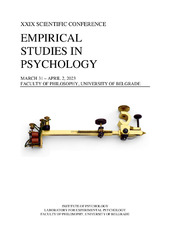Приказ основних података о документу
Construct and Predictive Validity of the Differentiation of the Self Inventory on University Students in Serbia
| dc.creator | Vuletić, Teodora | |
| dc.creator | Milojičić, Jelica | |
| dc.creator | Grujić, Kristina | |
| dc.date.accessioned | 2023-10-06T14:51:50Z | |
| dc.date.available | 2023-10-06T14:51:50Z | |
| dc.date.issued | 2023 | |
| dc.identifier.isbn | 978-86-6427-247-6 | |
| dc.identifier.uri | http://reff.f.bg.ac.rs/handle/123456789/4916 | |
| dc.description.abstract | As a developmental concept introduced by Bowen, differentiation of self points to a capability of distinguishing between intellectual and emotional processes behind personal experiences. The dominance of emotions manifests through dysfunction under stress, dependence on others, dissatisfaction with oneself, and fear of commitment; this could result in well-being difficulties, e.g., anxiety and depression. The present research aimed to validate the Differentiation of the Self Inventory (DSI, 46 items, Likert 1-6) in a Serbian sample of university students. The sample consisted of 364 emerging adults aged 18 to 30 (M = 21.44, SD = 2.36, 81.3% female). Items theoretically distribute on four subscales - Emotional reactivity (ER, 11 items), “I” Position” (IP, 11 items), Emotional Cutoff (EC, 12 items), and Fusion with Others (FO, 12 items). Initially, 12 factors were extracted using exploratory factor analysis (Principal components analysis, Promax rotation). Horn’s Parallel Analysis method suggested 6 factors should be kept. However, by examining the Structure and Pattern Matrices, we concluded that the four-factor solution would give the most interpretable results (38.66% of variance explained) and decided to use predefined summary scores. Psychometric properties of each subscale were on a satisfactory level (ER: α = .84; IP: α = .75; EC: α = .82; FO: α = .73). Construct validity was checked via confirmatory factor analysis (χ2 (973) = 2519.60, p < .00, RMSEA = .066, NFI = .619, CFI = .723). After connecting similar origin errors, the resultsindicated that the given model needs further improvement. The predictive validity of the DSI scale was examined by Depression Anxiety Stress Scale (DASS-SER, 42 items, Likert 0-3) and a well-being measure from Flourishing Scale (FS, 8 items, Likert 1-7). Predictors were scores on DSI subscales and criteria scores on DASS and FS scales. Results from regression analyses were on a satisfactory level (D: R2 = .41, F(4,355) = 60.60, p < .00; A: R2 = .30, F(4,355)=37.87, p < .00; S: R2 = .35, F(4,355) = 47.55, p < .00; FS: R2 = .37, F(4,355) = 52.23, p < .00), making differentiation of self a good predictor of depression, anxiety, stress, and wellbeing. In conclusion, the number of extracted factors remains debatable, but the instrument shows solid psychometric characteristics. Although some parameters limit the construct validity, the predictive validity and other presented results suggest that this instrument could be used in further research as a comprehensive measure. | sr |
| dc.language.iso | en | sr |
| dc.publisher | Belgrade: Institute of Psychology, Faculty of Philosophy, University of Belgrade | sr |
| dc.publisher | Belgrade: Laboratory for Experimental Psychology, Faculty of Philosophy, University of Belgrade | sr |
| dc.rights | openAccess | sr |
| dc.rights.uri | https://creativecommons.org/licenses/by/4.0/ | |
| dc.source | Proceedings of the XXIX Scientific Conference: Empirical Studies in Psychology | sr |
| dc.subject | differentiation of self | sr |
| dc.subject | validation | sr |
| dc.subject | well-being | sr |
| dc.subject | anxiety | sr |
| dc.subject | depression | sr |
| dc.subject | emerging adults | sr |
| dc.title | Construct and Predictive Validity of the Differentiation of the Self Inventory on University Students in Serbia | sr |
| dc.type | conferenceObject | sr |
| dc.rights.license | BY | sr |
| dc.citation.spage | 68 | |
| dc.identifier.fulltext | http://reff.f.bg.ac.rs/bitstream/id/12046/EIP2023_book_of_abstracts.pdf | |
| dc.identifier.rcub | https://hdl.handle.net/21.15107/rcub_reff_4916 | |
| dc.type.version | publishedVersion | sr |

